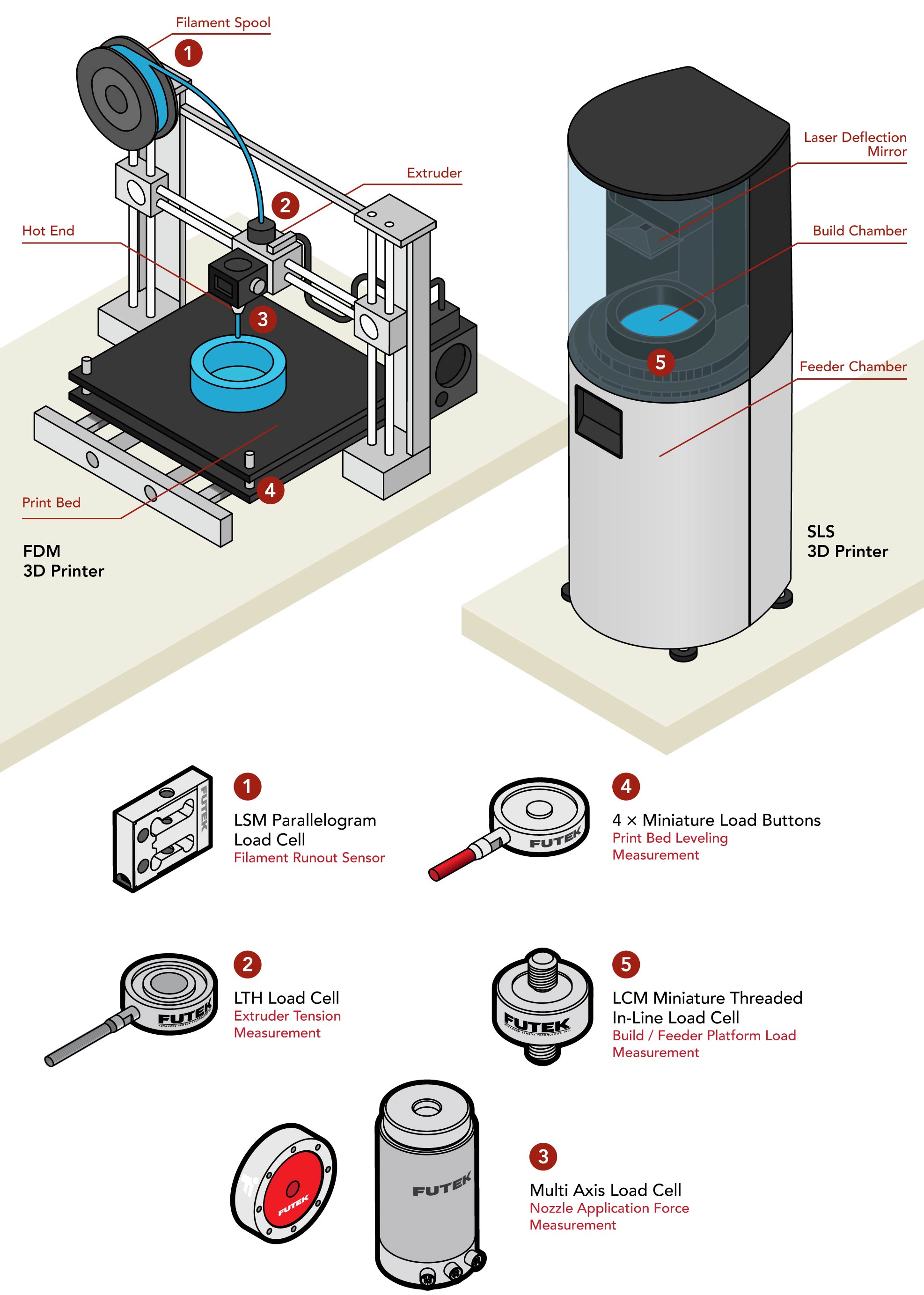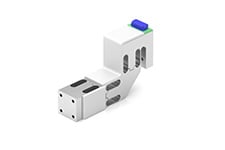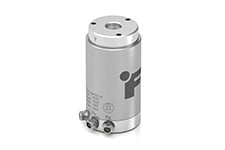Sensors used in 3D Printers
Load Cells and Force Sensors have revolutionized the world of 3D printing and additive manufacturing automation, bringing new levels of accuracy, reliability, and control to the printing process. These sensors are small, reliable devices that are capable of measuring force and converting it into an electrical signal. This electrical signal can then be used by an automated 3d printing control system to monitor and regulate various aspects of the printing process, such as filament runout, extruder pressure measurement, nozzle application force measurement, bed leveling, and build chamber weight measurement.
When your partner with FUTEK to find an optimal sensor solution for your 3D printing application, FUTEK’s sales team will work closely with your engineering design team to guide your sensor selection process and help you specify the correct load cell in terms of geometry, measurement range, and assembly requirements. Should your application require a custom solution, FUTEK excels at the development of OEM sensors. Our multidisciplinary engineering teams, high-precision machining centers, state-of-the-art quality assurance systems, and R&D and manufacturing facilities are fully equipped to tackle the most complex challenges.
How it Works
Filament Runout Sensor: In industrial 3D printers, ensuring the continuity of the printing process is key. When the printing starts, operators must ensure that there is enough filament or other raw material to complete the printing process, or the final product quality will be compromised.
The use of load cell sensors as filament runout sensors (or 3D printer filament runout sensor, 3D printer filament scale) has several benefits for FDM 3D printing. Firstly, it helps to prevent failed prints, which can be caused by a lack of filament or a filament jam. Secondly, it reduces the need for manual intervention, as the load cell sensor can be integrated with the printer control system to automatically pause the print when the filament is over.Extruder Tension Measurement: Extruder tension in 3D printing is how tightly or loosely the extruder gear is gripping your filament. If the 3D printer extruder tension (or pressure) is too high, the filament will get “chewed” by the extruder and the print quality can be affected, as the filament may not be able to flow through the hot end correctly. If the extruder pressure is too low, the filament may not be fed into the hot end correctly, causing jams or under-extrusion.
Load cells can be used to monitor the extruder pressure on Fused Deposition Modeling (FDM) 3D printers by being integrated into the spring tension assembly inside the extruder, where the filament is pushed by a drive gear into the hot end. The real-time 3D printer extruder force information can be used 3D Printer control system to adjust the spring tension in real-time.Nozzle Application Force Measurement: A multi-axis load cell sensor installed in the 3D Printer nozzle assembly measures the force applied in multiple axes, including the axial, radial, and tangential directions. This information can be used to regulate the extrusion process, ensuring that the correct amount of force is being applied and the extrusion is consistent. If too much force is applied during extrusion, it can signal to the printer control system to adjust the extrusion speed or pressure to avoid nozzle clogging or material breakage.
Print Bed Leveling Measurement: The load cell sensors measure the force applied to the bed surface at specific points, providing information on the level of the bed. The bed leveling data can be used in real-time to make automatic adjustments to the 3D Printer bed leveling system, ensuring that the bed is level and the first layer of the print has properly adhered. If the load cell sensors detect an uneven distribution of force, the bed leveling system can adjust the bed height at specific points, ensuring a level surface for the print.
Build / Feeder Platform Weight Measurement: In SLS 3D printing, the build platform is typically moved downwards using a piston, while the powder feed hopper is moved upwards using a separate piston. By integrating load cell sensors into these pistons, the pressure applied to the build platform and powder feed hopper can be monitored in real-time. The load cell provides information on the uniformity of the pressure applied to the build platform, allowing for real-time adjustments to ensure consistent, high-quality prints. In addition, the load cell sensors can be used to monitor the weight of the powder feed hopper, ensuring that the hopper is filled with enough powder for the next print and preventing the hopper from running empty during a print.
Contact Us
Please Contact Us with questions.
Sensors used in 3D Printers
Load Cells and Force Sensors have revolutionized the world of 3D printing and additive manufacturing automation, bringing new levels of accuracy, reliability, and control to the printing process. These sensors are small, reliable devices that are capable of measuring force and converting it into an electrical signal. This electrical signal can then be used by an automated 3d printing control system to monitor and regulate various aspects of the printing process, such as filament runout, extruder pressure measurement, nozzle application force measurement, bed leveling, and build chamber weight measurement.
When your partner with FUTEK to find an optimal sensor solution for your 3D printing application, FUTEK’s sales team will work closely with your engineering design team to guide your sensor selection process and help you specify the correct load cell in terms of geometry, measurement range, and assembly requirements. Should your application require a custom solution, FUTEK excels at the development of OEM sensors. Our multidisciplinary engineering teams, high-precision machining centers, state-of-the-art quality assurance systems, and R&D and manufacturing facilities are fully equipped to tackle the most complex challenges.



